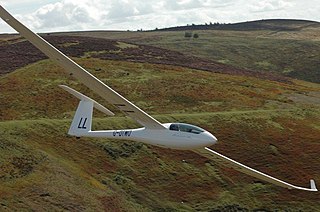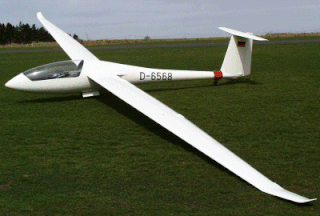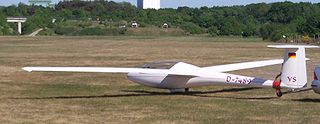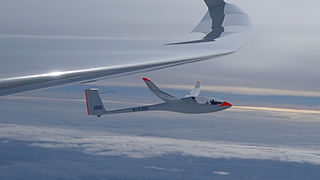Schempp-Hirth Flugzeugbau GmbH is a glider manufacturer based in Kirchheim unter Teck, Germany.
A motor glider is a fixed-wing aircraft that can be flown with or without engine power. The FAI Gliding Commission Sporting Code definition is: a fixed-wing aerodyne equipped with a means of propulsion (MoP), capable of sustained soaring flight without thrust from the means of propulsion. In the US, a powered glider may be certificated for up to two occupants, up to 850 kg maximum weight, and with a maximum ratio of weight to wing span squared of 3 kg/m2. Similar requirements exist in European JAA/EASA regulations, at a maximum weight of 750 kg.

The Schempp-Hirth Discus is a Standard Class glider designed by Schempp-Hirth. It was produced in Germany between 1984 and 1995 but has continued in production in the Czech Republic. It replaced the Standard Cirrus. It was designed by Klaus Holighaus.

The Schempp-Hirth Discus-2 is a Standard Class sailplane produced by Schempp-Hirth since 1998. It replaced the highly successful Schempp-Hirth Discus.

The Schempp-Hirth Ventus is a sailplane produced during 1980–1994 by Schempp-Hirth, a German sailplane manufacturer. It was designed by Klaus Holighaus and replaced the Schempp-Hirth Mini-Nimbus. Schempp-Hirth manufactured 613 Ventus sailplanes.

The Schempp-Hirth Ventus-2 is a sailplane produced by Schempp-Hirth since 1994. It replaced the highly successful Schempp-Hirth Ventus.

The Rolladen-Schneider LS8 is a Standard and 18 metre class single-seat glider developed by Rolladen-Schneider and in series production since 1995. Currently it is manufactured by DG Flugzeugbau.

The Rolladen-Schneider LS9 is an 18 metre single-seat motor glider launched in 2000 by Rolladen-Schneider. Production ended after just 10 gliders were built, when Rolladen-Schneider went into receivership.
Competition classes in gliding, as in other sports, mainly exist to ensure fairness in competition. However the classes have not been targeted at fostering technological development as in other sports. Instead classes have arisen because of:

HpH 304 is a family of sailplanes ranging from a single-seat composite 15 metre Class to a two-place 20 metre Open Class manufactured by the Czech company HpH Ltd. The sailplane was derived from a glider made by Glasflügel between 1980 and 1982 that was put back in production by HpH and who have modified it substantially and developed new models since.

The Glasflügel 303 Mosquito is a composite 15 metre Class single-seat sailplane manufactured by Glasflügel between 1976 and 1980.

The SZD-56 Diana is a 15 metre Class glider originally designed by Bogumił Bereś at PZL-Bielsko. However, PZL Bielsko went bankrupt before it could be put into serial production.

The Silent 2 Targa is a single seater sailplane of Italian manufacture. It is of the FAI DU Class glider. It is sold by Alisport ready-to-fly or kit-built as pure glider or self-launching glider. The self-launching version can be fitted with a single-blade propeller belt-driven by a two-stroke engine or with a double-blade folding propeller directly driven by an electric motor.

The Silent Club is a single seater sailplane of Italian manufacture. It is of the FAI type DU Class glider. It is sold by Alisport ready-to-fly or kit-built as pure glider or self-launching glider. The self-launching version is fitted with a single-blade propeller belt-driven by a two-stroke engine or optionally by an electric motor.

Lange Aviation GmbH is a German company that manufactures gliders and develops electric power-plants for other aircraft. It was founded by its present managing director, Axel Lange, in 1996 as Lange Flugzeugbau GmbH in Zweibrücken. The company currently has 42 employees. At the end of September 2007, the business was re-capitalised. Lange Faserverbundtechnik GmbH acquired all material and intellectual properties of the Lange Flugzeugbau GmbH and it continued the production of the Antares gliders at the airport at Zweibrücken. The company has operated since 2008 under the name Lange Aviation Gmbh.

The LAK-17 is a Lithuanian single-seat sailplane that was designed at the Lithuanian Aero Club, and is manufactured by Sportinė Aviacija.
Albastar AS are gliders produced by the Slovenian company Albastar Ltd. They are currently in the development stage.

The Schempp-Hirth Ventus-3 is a sailplane produced by Schempp-Hirth. It replaces the highly successful Schempp-Hirth Ventus-2.
The Schleicher AS 33 is a German glider manufactured by Alexander Schleicher. The prototype had its maiden flight from Huhnrain Airport, Poppenhausen near Frankfurt on 23 January 2020. The design can be flown in the 18 metre class or in the 15 metre class.
The Schleicher AS 34Me is a German glider manufactured by Alexander Schleicher. It is a self-launcher that uses an electrical propulsion system.














